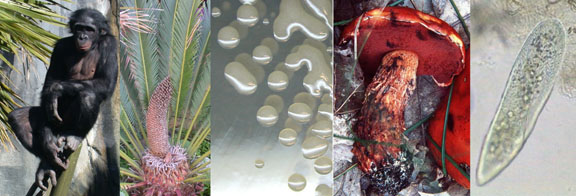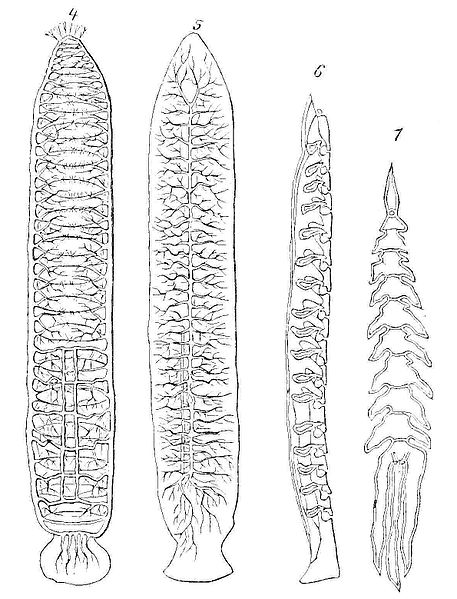The special on today's menu: BLOOD!
As you’ve probably guessed, Hirudo medicinalis enjoys a good blood dinner as a means for obtaining nutrition. So how can leeches live off of blood, and what adaptations have allowed them to obtain it? Read on to find out.
Why blood makes for a good dinner
Say its dinnertime, and you sit down and eat a nice juicy hamburger. The digestion process begins as soon as you start chewing the food. Enzymes in your saliva and the crushing action of your teeth start breaking down the bits of hamburger, as you enjoy the savory flavor. You swallow and the food goes down to your stomach where it’s broken down even further by acids and other enzymes in your stomach. Then, it goes to your small intestines where all sorts of nutrients are absorbed into your blood stream. You see, all of these nutrients are transported by your blood all throughout your body. A blood meal would be an excellent source of nutrition, since it is the medium in which all sorts of vitamins, minerals, proteins, fats, and sugars are transported. It’s like the world’s best all-natural energy drink and it’s not surprising that some animals have adapted to suck the blood from animals.
What obstacles must be overcome?
Hirudo
medicinalis
is considered to be an ectoparasite that feeds on the blood of a
host, and has specialized features that allow it to live this
lifestyle. First, the leech has developed several sensitive sensory
organs that it uses to detect the presence of possible prey (Check out
the
Adaptations page for more information about senses). Often, it’s a mammal or a
frog that has jumped into a pond or marsh where the leech is waiting at the
bottom. The leech goes over to check it out, and if it seems edible, will find
a nice tender area of skin and make an incision with its specially modified
anterior sucker (the smaller end). This sucker has three jaws that have sharp
teeth with serrated edges. The leech rocks the teeth back and forth, making the
characteristic “Y” shaped incision in the skin.
Let’s say you wanted to be an organism that fed off of blood. What other types of adaptations would you probably need? First, you probably wouldn’t want to be detected by the prey. Obtaining blood from an organism would probably involve piercing the skin, making your presence apparent to them. Hirudo medicinalis overcomes this by producing a mild anesthetic that temporarily numbs the area, allowing it to get away with its meal basically unnoticed. Okay, but we all know that when we get cut, it eventually forms a clot and stops bleeding. Hirudo medicinalis gets past that obstacle by producing a very important anticoagulant called hirudin, and also a vasodilator that allows the blood to easily flow out of the wound. Without the anticoagulant, the blood would thicken inside of the leech, making it impossible to reproduce, eat anything else, or even move; all of which would eventually lead to the leech’s demise. Hirudin is especially important for the medical use of the leech. (Read the Medicinal Use section for more information)
When
the leech has a meal, the blood enters into the crop(or stomach), which is
modified to hold large quantities. In fact, it can engorge itself with up to 10
times its body weight in blood! (That’s like a 180 pound man eating 1,800
pounds of food in one sitting!) Enzymes produced by the leech and symbiotic
bacteria that reside in the crop aid in the breakdown of the blood. The
breakdown of a good blood feast isn’t a fast process, and the leech can go six
months, to even a year without another meal. After the enzymes and
bacteria do their magic, it is then passed down to the intestines where it can
be absorbed into the blood system. Hirudo medicinalis has a closed circulatory
system, meaning the blood is contained within blood vessels. They have four
sinuses that act like a heart to pump the blood around its body. The blood
enters capillaries(tiny, thin-walled vessels) which provide the tissues with the
blood supply. The leech's blood has a red color due to the same protein
found in our blood--hemoglobin. Oxygen attaches to the hemoglobin so that it
can be circulated throughout its body to the cells of the leech. Exchange of
oxygen and carbon dioxide does not occur in lungs or gills in Hirudo
medicinalis but simply occurs through the surface of its skin. A simple,
yet effective method for this particular organism.
| Click on the link below to visit the University of La Crosse website | Click on the link below to see other organism websites made by UW-L students at multipleorganisms.net |
 |
 |


